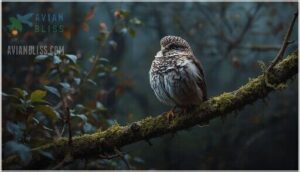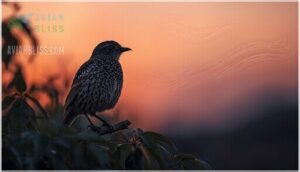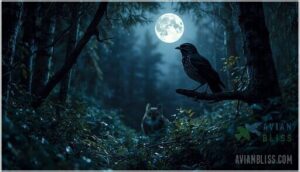This site is supported by our readers. We may earn a commission, at no cost to you, if you purchase through links.

But once the sun sets, these aerial hunters transform into precision insect-catching machines, scooping moths and beetles from the air with bristle-fringed mouths that work like living nets. Their soft feathers muffle flight sounds while oversized eyes gather every photon of available light.
You’ll find nightjars on every continent except Antarctica, from tropical forests to suburban parks, yet most people live their entire lives without spotting one—a proof of camouflage so effective it borders on magic.
Table Of Contents
- Key Takeaways
- Nightjar Identification and Characteristics
- Nightjar Habitat and Distribution
- Nightjar Diet and Foraging
- Nightjar Nesting and Breeding
- Nightjar Conservation and Threats
- Nightjar Behavior and Social Structure
- Nightjar Migration and Movement Patterns
- Nightjar Predators and Mortality
- Nightjar Research and Monitoring
- Fun Nightjar Facts and Interesting Insights
- Frequently Asked Questions (FAQs)
- Are there nightjars in the US?
- What is the myth about nightjars?
- Why is it called a nightjar?
- Is a nightjar a bird or an owl?
- How does climate change affect nightjars?
- Why are nightjars calls important for identification?
- How do nightjars interact with urban environments?
- What are the cultural significances of nightjars globally?
- How do nightjars compare to other caprimulgids?
- How long do nightjars typically live in the wild?
- Conclusion
Key Takeaways
- Nightjars rely on cryptic plumage and nocturnal habits to avoid detection, blending seamlessly into bark and leaf litter during daylight while hunting insects at night with specialized adaptations like oversized eyes, bristle-fringed mouths, and silent flight feathers.
- These birds face significant threats from habitat loss, pesticide exposure, light pollution, and climate change, which has already reduced genetic diversity by 33% and could extend migration distances by over 40%, making conservation efforts critical for their survival.
- Nightjars play a vital role in ecosystems by controlling insect populations—consuming up to 2,000 insects per night—and their breeding success depends on mosaic landscapes that combine open nesting areas with insect-rich foraging grounds within short distances.
- Despite dramatic population declines of over 50% between 1950 and 1980, targeted habitat restoration and monitoring efforts have produced recovery successes, with some UK populations rebounding significantly through heathland management and protected reserve systems.
Nightjar Identification and Characteristics
If you’ve ever tried spotting a nightjar, you know they’re masters of disguise. Identifying these birds takes a closer look at their physical features, calls, and how they compare to similar species.
Here’s what you need to know to recognize a nightjar when you encounter one.
Physical Features and Plumage
Nightjars are masters of disguise, sporting cryptic plumage that makes them nearly invisible against tree bark and leaf litter. When you spot one, you’ll notice their mottled feathers blend brown, grey, and black into perfect camouflage techniques. Sexual dimorphism shows up in males’ bold white wing patches, while females stay subtler.
Their bird physical attributes include:
- Soft feather structure reducing flight noise for silent hunting
- Large eyes with light-reflecting layers boosting nocturnal vision
- Wide mouths fringed with bristles to funnel insects
- Plumage variations ranging from grey-brown to reddish hues
- Elongated wings spanning 57–64 cm in European species
These sensory adaptations transform nightjars into nocturnal specialists, perfectly equipped for life after dark. They’re classified as an Amber species due to conservation concerns.
Distinctive Calls and Sounds
Beyond their camouflage, you’ll recognize nightjars by their distinctive vocalizations. European nightjar males produce two song types: churring trills lasting over two minutes, or shorter songs with terminal phrases and wing claps.
These nocturnal bird species peak vocally at dusk and dawn, with call individuality allowing acoustic monitoring to identify specific birds. Frequency ranges span 2–5 kHz, and males may belt out thousands of calls nightly. This vocal repertoire—from monotone purrs to sharp alarm notes—sets nightjars apart in the soundscape of vocal behavior research.
Passive acoustic monitoring is useful for detecting these elusive birds.
Similarities to Other Bird Species
While nightjar vocalizations stand out, their physical traits show striking convergent evolution with several bird groups. You’ll notice nocturnal ecology parallels with owls—both possess tapetum lucidum eye structures that boost night vision efficiency by 50%.
Their plumage camouflage mimics frogmouths and potoos, all three sharing bark-like feather patterns.
Flight adaptations reveal genetic overlap within Caprimulgiformes, where molecular studies document up to 8% shared DNA among genera through historical hybridization.
Nightjar Habitat and Distribution
Nightjars have carved out a home in nearly every corner of the planet, adapting to landscapes as different as tropical rainforests and urban parking lots. Understanding where these birds live and how they move across continents reveals much about their striking flexibility.
Let’s look at their global range, favorite habitats, and the impressive journeys many species make each year.
Global Distribution and Range
You’ll find nightjars on every continent except Antarctica, demonstrating striking nightjar global distribution across diverse climates. Their continental presence spans from sea level to elevational limits of 4,200 meters, with some species wintering at 5,000 meters in African highlands.
Consider these range subdivisions:
- Americas: 12 genera from northern Canada to Argentina
- Eurasia-Africa: Over 100 species with migratory connections spanning 10,000+ km annually
- Asia-Oceania: Resident populations across India and Southeast Asia
Population density varies dramatically—Europe hosts 3–6 million individuals, while island species occupy tiny, localized ranges. This geographic distribution of birds reflects striking nightjar habitat diversity, from moors to savannas, though dense urban centers mark their biogeographic limits.
Preferred Habitats and Landscapes
When choosing nesting territory, nightjars seek open habitat with less than 40% ground cover—think heathlands, young plantations, and moorlands rather than dense forests. Bird habitat selection depends on landscape configuration, with breeding success highest where nesting sites sit near insect-rich grasslands. Yet habitat fragmentation forces longer foraging trips, stressing populations already facing human impact. Altitudinal variation matters too: you’ll spot them from sea level to 2,800 meters during breeding, even 5,000 meters in African winters.
| Habitat Type | Key Features |
|---|---|
| Heathlands | Open terrain, <20% tree cover, disturbed ground |
| Young Plantations | Active, early succession, sparse canopy |
| Moorlands | Upland areas, low vegetation, minimal human disturbance |
| Managed Grasslands | Hedgerows, isolated trees, high insect availability |
Nightjar habitat diversity requires mosaic landscapes—nightjar habitats and ranges thrive where complementary environments connect within short distances, supporting both nightjar habitat and range needs across their lifecycle.
Migration Patterns and Routes
How do these nocturnal travelers navigate thousands of kilometers twice yearly? European nightjars undertake long-distance migration spanning over 8,600 km from Western Europe to sub-Saharan Africa, with North American common nighthawks flying up to 10,000 km to South America.
Bird migration patterns reveal impressive endurance: migratory birds complete approximately 57 flight episodes during roundtrip journeys, spending 62 days on autumn migration alone.
- Migration timing peaks 11 days after full moons, showing lunar influence on travel intensity
- Route barriers like the Mediterranean and Sahara are crossed directly without detours
- Flight altitude increases dramatically over deserts, with lower elevations elsewhere
- Stopover sites in Northern Africa and the Sahel provide critical refueling, with median stays of 22 days
Nightjar migratory patterns demonstrate complex navigation, balancing energy conservation with obstacle avoidance across continents.
Nightjar Diet and Foraging
Nightjars are specialized hunters, feeding almost exclusively on flying insects they catch in mid-air. Their unique physical adaptations and hunting strategies make them highly efficient nocturnal predators.
Let’s look at what they eat, how they hunt, and the role they play in controlling insect populations.
Types of Prey and Hunting Techniques
You’ll find nightjars targeting flying insects with striking precision, capitalizing on prey biomass that peaks during wet seasons—moths alone can make up over 90% of their catch. Their hunting tactics rely on anatomical adaptations like oversized eyes and a 42° binocular overlap angled upward, perfect for spotting prey against the sky.
Foraging patterns shift with seasonal influences, as these insectivores adjust their nocturnal hunting techniques based on insect availability and lunar conditions. Understanding nightjar feeding ecology reveals how these birds make hundreds of foraging movements nightly, sometimes traveling over 2,600 meters from their nests to prime hunting grounds where insect activity peaks at dusk.
| Hunting Method | Key Features |
|---|---|
| Sit-and-Wait Attacks | Launch from ground perches to intercept overhead insects |
| Aerial Pursuit | Direct chases using rapid maneuvers and silent flight |
| Gape-and-Capture | Wide mouth with bristles funnels prey during flight |
Role of Nightjars in Ecosystems
When insects swarm at dusk, you’re watching pest regulation in action—nightjars can devour up to 2,000 insects per night, keeping populations in check without pesticides. Their feeding ecology connects them to trophic webs as both predator and prey, while habitat influence shapes where these nocturnal insectivores hunt most effectively.
Key ecosystem services nightjars provide include:
- Natural pest control that rivals chemical methods, protecting crops near their habitats and reducing agricultural losses
- Energy redistribution through species interactions, as they concentrate foraging in insect-rich zones and become prey for foxes and raptors
- Biodiversity support by maintaining semi-open landscapes with 20–50% tree coverage, creating conditions other insectivores need to thrive
Adaptations for Nocturnal Foraging
You’re looking at specialized flight masters that hunt in near-total darkness—nightjars rely on enhanced night vision, with retinas packed with rod cells to spot moths in moonlight.
Their large wingspans enable aerial hunting up to six kilometers from nest sites, while rictal bristles funnel insects mid-flight.
These nocturnal birds can even enter torpor for eight days when prey is scarce, conserving energy until conditions improve. Sensory adaptations and metabolic strategies make nightjar feeding habits remarkably efficient.
Nightjar Nesting and Breeding
When nightjars settle down to raise their young, they don’t build nests like most birds—they rely on camouflage and ground cover instead. Their breeding strategies reflect the same stealth and simplicity that define their nighttime hunting.
Here’s what happens during mating, egg-laying, and the care of their chicks.
Mating and Pair Bonding
When you find a nightjar in the wild, you’re likely witnessing social monogamy in action—about 87% of species form pair bonds lasting at least one breeding season. Courtship displays bring the show to life: males flash white wing spots and deliver churring calls that change structurally after pairing, helping females assess mate quality through vocal recognition. Mating seasonality runs May through September, syncing with insect peaks and moonlit nights that boost breeding behaviors.
Here’s what drives their breeding grounds dynamics:
- Extra-pair paternity occurs in roughly 23% of offspring, rising where male density increases
- Pair bond duration generally spans one season, though some pairs reunite across years
- Breeding season timing aligns with longer days and lunar cycles for best foraging
Nesting Sites and Egg-Laying
Once paired, you’ll see nightjars skip nest-building entirely—they lay eggs directly on bare ground among leaf litter or beneath shrubs. Nesting habits favor heathland and forest clearings, where European nightjars reach densities of 20 breeding pairs per square kilometer in prime habitat. Clutch size variation stays narrow: usually one to two eggs per attempt. Egg coloration delivers striking camouflage—buff tones marked with lilac and brown blotches blend seamlessly into surroundings.
Nesting success rates vary dramatically—55% of nests fail due to predation, mostly from foxes. Breeding behaviors sync with lunar cycles and seasonal rains, boosting insect availability. The incubation period averages 18 days, setting the stage for what comes next.
| Nesting Aspect | Details |
|---|---|
| Nest site selection | Ground scrapes in heathland, dry forest, beneath vegetation |
| Clutch size | 1–2 eggs; laying interval 36–48 hours |
| Egg specs | 32×22 mm, 8.4 g; buff with brown/lilac markings |
| Breeding season timing | Late May–August; peaks two weeks before full moon |
Incubation and Parenting Behaviors
After the 18-day incubation period, you’ll notice female nightjars handling most egg-warming duties while males chip in briefly at dawn or dusk. Incubation duration spans 17–21 days for European nightjars, with parental roles shifting as breeding season progresses.
Chick development moves fast—young fledge within 16–21 days and gain independence around 32 days post-hatch.
Nest success hinges on environmental influences like moon phase and moth abundance, which directly affect survival rates. One study found only 14.5% of eggs survived to hatching, though fledging success improved once chicks emerged.
These nightjar breeding behaviors and nesting habits showcase striking adaptation to unpredictable conditions.
Nightjar Conservation and Threats
Nightjars face mounting pressures that threaten their survival across much of their range. Understanding what’s putting these nocturnal hunters at risk—and what’s being done to help—matters if you care about keeping these birds around.
Here’s what you need to know about the challenges nightjars face and the efforts underway to protect them.
Historical Decline and Recovery
Between 1950 and 1980, you could witness nightjar populations plummet by more than 50% across northwestern Europe, with Britain losing half its breeding birds by 1992 and Ireland suffering an 88% decline. Population bottlenecks triggered genetic diversity loss—about 33% over 180 years—while habitat fragmentation isolated breeding groups.
Conservation successes followed targeted efforts:
- UK populations surged 230% in Welsh forests between 1981 and 1989
- RSPB reserves reached record counts of 211 nightjars in 2024
- Heathland restoration in Dorset supported 93 returning birds
- Thetford Forest restock zones created ideal breeding densities
- Future monitoring using GPS tracking links population viability to landscape connectivity
Nightjar conservation demonstrates how dedicated habitat management reverses decline, though conservation challenges persist as genetic restoration remains critical for long-term resilience.
Current Threats and Challenges
While recovery shows promise, nightjar conservation faces mounting challenges in the modern world. Habitat loss fragments breeding grounds—Britain’s populations dropped over 50% by 1981 as heathlands vanished.
Pesticide exposure decimates insect prey, reducing body mass and disrupting migration timing. Light pollution from urbanization suppresses calling activity where thriving populations are expected.
Climate change could stretch migration distances 40% longer, turning the drying Sahel into a deadly bottleneck. Genetic diversity keeps sliding, weakening adaptability. Bird conservation status remains precarious without addressing these interconnected threats simultaneously.
Conservation Efforts and Management Strategies
Through smart habitat restoration and tech innovation, nightjars are finally getting the protection they deserve. You’ll find conservation challenges tackled through:
- Habitat Restoration: RSPB’s heathland work recorded 211 nightjars in 2024—the highest ever
- Policy Frameworks: Special Protection Areas safeguard critical breeding grounds across Europe
- Tech Innovation: AI-powered TrailGuard sensors cut ranger response time by 40%
- Community Engagement: Volunteers contribute 20,000+ annual hours through monitoring networks
- Global Coordination: The Global Nightjar Network unites researchers across 20+ countries
The future of nightjar conservation depends on maintaining these coordinated efforts across continents.
Nightjar Behavior and Social Structure
Nightjars don’t follow the typical bird playbook regarding social life. These solitary hunters operate under cover of darkness, and their behavior reflects that independent streak.
Here’s what you need to know about how nightjars interact with each other and claim their space.
Territoriality and Aggression
When breeding season kicks in, male nightjars transform into vocal defenders of their turf. Territory size varies dramatically—from compact 1.5-hectare patches to sprawling 32-hectare domains, depending on habitat quality. Males advertise ownership through mechanical “churring” calls that can drone on for minutes, especially at dusk.
Physical aggression is rare; most conflicts are brief aerial chases under 10 seconds.
However, artificial light influence disrupts this social structure, slashing territorial activity by up to 88% in urban areas and weakening the nightjar behavior patterns that define breeding season behaviour.
Mating and Courtship Behaviors
During dusk and dawn in breeding season, male nightjars launch into aerial displays, gliding with V-shaped wings and fanned tails to flash white ornaments at potential mates. These courtship rituals rely on visual showmanship and repetitive churring vocalizations that can last several seconds. Females base mate choice on ornament size, preferring older males with larger tail markings—a signal of quality and territory dynamics.
- Males showcase white wing and tail patches during glides
- Churring calls advertise fitness throughout breeding habits
- Ornament size directly influences mating system success
This nesting breeding strategy links display intensity to territory quality and breeding behaviors.
Social Interactions and Communication
Nightjars don’t flock like starlings, but their vocal communication weaves a rich tapestry of social signals. Males produce churring vocalizations that pulse through the night—individual European nightjars vary their phrase lengths across nights, allowing neighbors to recognize each other. Territorial savanna nightjars can deliver over 13,000 calls in a single evening, staking acoustic claims even in noisy environments. During full moons, some Neotropical species ramp up their vocal repertoire six to eight times, possibly coordinating activity to reduce predation risk.
| Behaviour Type | Function |
|---|---|
| Churring songs | Territory defense and mate attraction |
| Alarm calls | Warning conspecifics of predators |
| Contact calls | Maintaining spacing in dense habitats |
Roosting dynamics reveal subtle interspecific interactions—Long-tailed Nightjars occasionally rest in groups of two or three, while most species remain solitary. Territoriality peaks during breeding, with White-winged males defending 30-meter display arenas under moonlight, their vocalizations serving as invisible fences in the darkness.
Nightjar Migration and Movement Patterns
Nightjars don’t stay put—many species travel thousands of miles between breeding and wintering grounds, while others make shorter seasonal shifts in elevation.
Understanding where these birds go and how they get there reveals the challenges they face throughout the year. Here’s what you need to know about their impressive journeys.
Long-Distance Migration Routes
When you think about long-distance migration, European nightjars cover over 8,600 km from breeding grounds to Central Africa’s wintering sites—a journey taking about two months. These migratory patterns involve crossing the Mediterranean Sea and Sahara Desert, with birds using strategic stopover zones in semi-open habitats to refuel. Research advances using GPS tracking reveal that nightjars complete their round-trip through 57 separate flight episodes, with seasonal patterns showing much more flights during spring migration. Climatic influences and wind conditions shape their routes, while migration distances may increase over 40% due to environmental pressures.
- Direct routes traverse Europe, Mediterranean, and Sahara before reaching sub-Saharan Africa
- Strategic stopovers in hospitable biomes allow refueling during the 62-day autumn journey
- Nocturnal travel maximizes crepuscular migration windows while resting motionless by day
- Spring crossings involve noticeably higher flight altitudes, especially over desert barriers
Altitudinal Migration and Movement
You’ll find flight altitudes during long-distance migration reach impressive heights—European nightjars climb to nearly 5,000 meters crossing the Sahara Desert. These migratory patterns show biome dependency, with birds averaging 1,168 meters over barriers versus 576 meters in hospitable terrain.
Ascent dynamics reveal energy efficiency through moderate climbing speeds of 0.67 meters per second, while regional variability emerges as spring migration involves more vertical exploration than autumn.
This habitat diversity shapes nightjar migration patterns greatly.
Stopover Sites and Migration Strategies
After nightjars reach these heights, their stopover sites become essential for survival during long-distance migration. European nightjars traveling over 8,600 kilometers select refueling hotspots across Southern Europe and the Sahel, though stopover habitat loss threatens these essential areas—projected declines approach 49% by century’s end.
You’ll notice migration speed variations between biomes: they rush through deserts at 275 kilometers daily but relax in savannahs, alternating between flight and foraging. This migration tactic flexibility helps migratory birds adapt their refueling strategies as climate change effects reshape traditional routes.
Nightjar Predators and Mortality
Nightjars face threats from multiple directions, both natural and human-made. Understanding what endangers these nocturnal birds helps explain why some populations are struggling.
Let’s look at the main sources of nightjar mortality and how they’re affecting populations worldwide.
Natural Predators and Threats
In the wild, nightjars face significant threats from various predators. Avian predators like owls and harriers hunt them at night, while mammalian threats such as foxes and badgers frequently raid their nests. Foxes, in particular, are responsible for the majority of egg-stage failures in UK heathlands. Reptilian predation from adders and snakes is most prevalent during incubation periods. The vulnerability of nightjar nests is heightened as their eggs are laid directly on bare ground, making anti-predator adaptations essential.
Their nocturnal habits and cryptic plumage aid in predator avoidance, but conservation efforts face challenges in degraded habitats where behavioral adaptations alone are insufficient.
- Owls and harriers target adults during nocturnal resting periods
- Foxes cause over 20% of nest losses in disturbed heathlands
- Adders prey on incubating adults during early summer months
- Crows and magpies destroy eggs in areas with low vegetation cover
- Injury-feigning displays lure foxes away from vulnerable nests
Human-Induced Mortality and Threats
Beyond natural predators, human activities pose even greater risks. Road traffic mortality is startling—Red-necked Nightjars in Spain average 5.1 roadkill casualties weekly during peak seasons.
Habitat fragmentation has slashed genetic diversity by nearly 35% over 180 years, while pesticide exposure from neonicotinoids contaminates their insect prey.
Human disturbance from recreation disrupts breeding, and invasive species like mongooses and feral cats attack ground nests.
These conservation challenges demand habitat diversity protection and reduced vehicular speeds in critical areas to secure nightjar conservation and research’s prospects.
Impact of Climate Change on Nightjar Populations
Human activity compounds the problem, but climate change hits nightjars on multiple fronts. Migration barriers increase by over 40% under worst-case warming scenarios, forcing longer journeys through degrading stopover zones.
Phenological mismatch disrupts breeding—chicks hatch before moth populations peak, slashing survival rates. Habitat turnover reshuffles global distribution by up to 72%, creating conservation challenges in addressing unpredictable landscapes.
Meanwhile, prey availability plummets as insect biomass crashes during temperature swings. Genetic diversity losses—already down 35%—limit adaptive capacity.
Future nightjar conservation and research must address these interconnected threats across habitat diversity and migration corridors to secure populations.
Nightjar Research and Monitoring
Understanding nightjars means getting into the field and tracking these elusive birds. Researchers use creative techniques to study populations that spend most of their time hidden in darkness.
Here’s how scientists monitor nightjars and what we’re still learning about them.
Tracking and Monitoring Techniques
Modern technology has cracked open the nightjar’s secret world. GPS tagging devices—weighing less than 5% of body mass—track long-distance migration routes and distribution patterns, recording locations hourly throughout the night. Meanwhile, acoustic monitoring with automated recorders boosts detection rates by 217% over traditional surveys, capturing those distinctive calls researchers might otherwise miss.
- Remote download capability retrieves data without recapturing birds, reducing stress
- Data analysis using kernel density estimation maps home ranges averaging 23.6 km²
- Ethical considerations guide all deployments, minimizing behavioral impact
- Research challenges include battery limitations restricting tracking to under two months
These conservation tools reveal movement patterns essential for protecting nightjar habitats in our changing world.
Population Studies and Surveys
Long-term population studies reveal nightjar conservation challenges through standardized survey methodologies and habitat fragmentation analysis. Since 2007, coordinated surveys across North America track three species using 6-minute roadside counts during bright moonlit nights—observers stop every half-mile, listening without playback to document calls and flight patterns.
You’ll find these key insights emerging from global distribution research:
- European nightjar populations dropped over 50% between 1966-1981, with British populations rebounding 36-50% by 2004 despite ongoing habitat fragmentation.
- Population genetics studies show declining genetic diversity over two centuries, increasing vulnerability to decline causes like climate shifts.
- Russian breeding populations reached 500,000 pairs while Spain hosted 112,000, illustrating varied conservation impact across bird distribution ranges.
Citizen science initiatives now generate essential population studies data, helping researchers understand how bird habitat loss and insect declines affect these nocturnal hunters across continents.
Research Priorities and Future Directions
Across continents, researchers are tackling nightjar biology challenges through conservation policy integration and modern tracking techniques. Priority areas include genetic monitoring, where British studies revealed a 33% genetic diversity loss over 180 years, and climate modeling, which predicts migration distances could increase by 40% by 2100. Habitat restoration projects aim for a 20-30% heathland expansion by 2030, relying on ecological forecasting tools that link breeding grounds to wintering sites.
Conservation challenges in the modern world require cross-border frameworks to harmonize data from over 36,000 nightjar detections globally. Nano-GPS tags and acoustic AI have boosted tracking efficiency by 38%, shaping the trajectory of nightjar conservation and research by enhancing understanding of nightjar adaptations.
| Research Priority | Key Focus |
|---|---|
| Genetic Monitoring | Tracking diversity loss and inbreeding patterns |
| Climate Modeling | Predicting migration route shifts through 2100 |
| Habitat Restoration | Creating connectivity corridors between populations |
| Tracking Technology | Nano-GPS tags and acoustic AI detection systems |
| Policy Integration | Cross-border conservation frameworks by 2028 |
Fun Nightjar Facts and Interesting Insights
Nightjars pack more surprises than you might expect from a bird that spends its days pretending to be a stick. Beyond their impressive camouflage and silent flight, these birds carry fascinating traits, cultural tales, and behaviors that reveal just how extraordinary they really are.
Let’s explore what makes nightjars truly stand out.
Unique Characteristics and Traits
You’ll find nightjars packed with fascinating adaptations that make them masters of the night. Their nocturnal vision relies on eye structures rich in rod cells, letting them spot flying insects in near darkness. Here’s what sets them apart:
- Cryptic plumage creates camouflage so effective they vanish against bark and leaf litter during daylight rest.
- Silent flight comes from specialized feathers with soft edges, letting them approach prey undetected.
- Rictal bristles fringe their wide mouths, funneling insects straight into their throats mid-flight.
- Aerial agility combines quick wingbeats with smooth gliding, perfect for chasing moths through shadowy forests.
Nightjar Myths and Folklore
For centuries, nightjars sparked dark legends across cultures. Europeans branded them “goat suckers,” convinced they stole milk from livestock—a myth so persistent it shaped their scientific name, Caprimulgidae. Their eerie calls earned them grimmer titles: death omens and soul birds.
In New England, hearing a whip-poor-will meant someone would soon die. Medieval folklore linked nightjars to witchcraft legends, casting them as witch familiars haunting moonlit fields.
These folklore symbols reveal nightjar classification through human fear—nocturnal habits breeding superstition. Yet their cultural significance endures, reminding you that nightjar myths often say more about us than the birds themselves.
Interesting Nightjar Behaviors and Adaptations
Nightjars don’t just hide—they vanish. You’ll find them selecting nesting sites that match their cryptic plumage down to the centimeter, making them 2.4 times more likely to survive.
Their nocturnal vision relies on specialized retinal cells for aerial hunting in near-darkness, while Silent Flight feathers let them approach prey undetected. During moonless nights, some species enter torpor to conserve energy.
Males spend 33% of the breeding season foraging using Moonlight Foraging tactics, while their Adaptive Migration covers 8,600+ kilometers with strategic stopovers in grasslands where insecteaters thrive.
Frequently Asked Questions (FAQs)
Are there nightjars in the US?
You’ll find at least five confirmed species in the United States, including the Common Nighthawk and Chuck-will’s-widow. The Common Nighthawk ranges widely across North America, even adapting to urban areas, while species like the Lesser Nighthawk prefer southwestern deserts.
Though populations face decline from habitat loss and light pollution, conservation efforts continue monitoring these nocturnal birds.
What is the myth about nightjars?
The term “goatsucker” comes from an ancient European superstition that blamed nightjars for stealing milk from livestock. This folklore belief arose from misinterpreting their nocturnal behavior—these birds hunt flying insects near farms at dusk, not goats.
Their silent flight and wide mouths sparked myths about them draining udders, even causing blindness in herds.
Why is it called a nightjar?
At dusk, when their churring call breaks the stillness, you’ll understand the etymology origins perfectly.
The name combines “night” with “jar,” describing these nocturnal birds’ jarring sounds—especially the male’s distinctive churr during breeding season, first documented around 1630 for the European species.
Is a nightjar a bird or an owl?
You might assume they’re owls, but nightjars are actually their own family of nocturnal birds. Bird classification places them in Caprimulgidae, separate from owls.
While owl comparison shows both hunt after dark, nightjars catch insects mid-flight with wide, bristle-fringed mouths—nature’s aerial hunters with distinctive flight patterns.
How does climate change affect nightjars?
Imagine this: your entire neighborhood vanishes overnight, replaced by an inhospitable wasteland. That’s the reality nightjars face as climate change reshapes their world. Rising temperatures and shifting weather patterns force these nocturnal birds to extend migration distances by over 40%, while habitat loss shrinks critical stopover sites by nearly half.
You’ll notice they’re arriving at breeding grounds about six days later than a decade ago, disrupting their carefully timed reproductive cycles. Extreme weather events destroy nesting areas, and changing insect populations—their primary food source—leave them struggling to find adequate nutrition.
These adaptive strategies aren’t enough to offset the mounting conservation challenges, making habitat diversity protection essential for their survival.
Why are nightjars calls important for identification?
Calls are essential because they work when you can’t see the bird. Acoustic signatures reveal species and even individual nightjars in the dark, with bioacoustic analysis identifying birds correctly around 95% of the time based on churring patterns and whippoorwill-like vocalizations.
How do nightjars interact with urban environments?
Like moths drawn to a flame, nightjars navigate urban spaces with surprising finesse. You’ll find them nesting on rooftops and hunting insects near streetlights, though artificial light disrupts their natural rhythms and noise pollution hampers prey detection, forcing them to forage during quieter hours.
What are the cultural significances of nightjars globally?
Across cultures, nightjars carry profound spiritual significance and mythical associations. European folklore links them to death and unbaptized souls, while indigenous North American traditions view their calls as omens.
Their nocturnal legends and cultural symbolism reflect humanity’s fascination with these mysterious birds and their haunting presence in folklore studies worldwide.
How do nightjars compare to other caprimulgids?
Caprimulgidae members share core traits—nocturnal hunting, cryptic plumage, aerial insectivory—but nightjars show striking heat tolerance.
You’ll find them roosting in sunlit spots while other caprimulgids seek shade, demonstrating exceptional adaptability in extreme temperatures across diverse habitats.
How long do nightjars typically live in the wild?
You’ll find that most nightjars live around 4 to 6 years in the wild, though some European Nightjars have reached impressive age records of 12 to 13 years under favorable conditions and minimal threats.
Conclusion
Perhaps nightjars deserve an award for “Most Likely to Be Mistaken for a Tree Branch”—though they’d never show up to accept it. These masters of disguise spend daylight hours perfecting their impression of dead wood while the rest of us stumble past, oblivious.
Yet their survival depends less on our appreciation and more on preserving the dark, insect-rich habitats they’ve hunted for millennia. Without action, we’ll lose not just nightjars but the silent magic they bring to summer nights.















